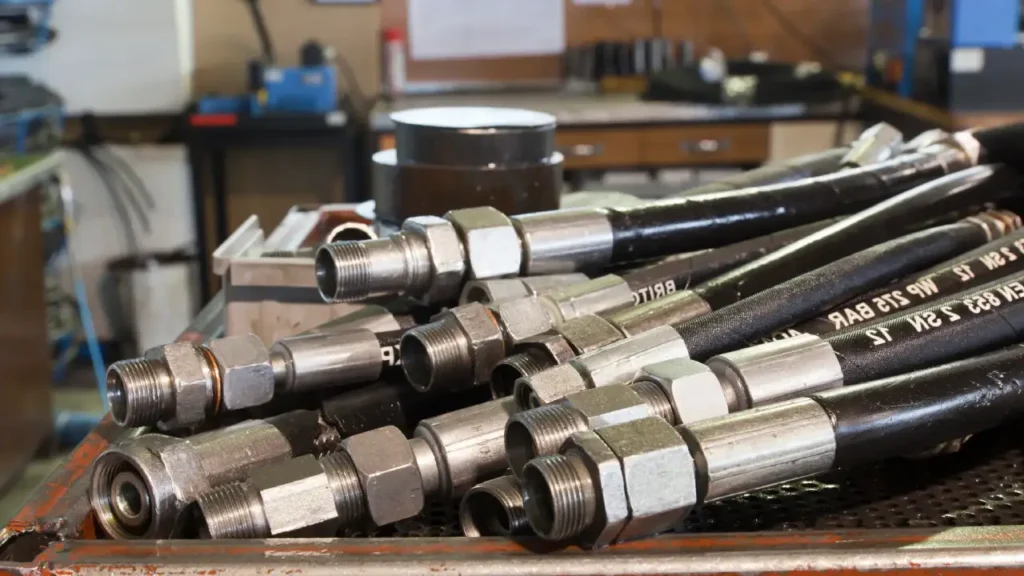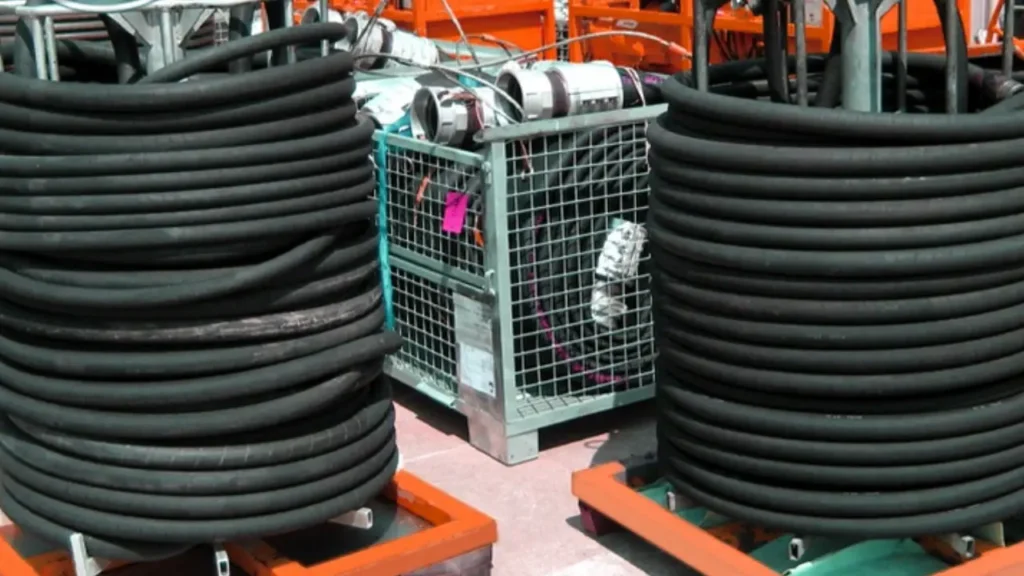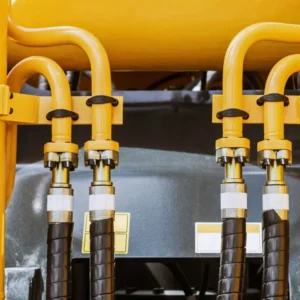Hydraulic hoses are essential components in many industries, from construction and agriculture to manufacturing and mining. Proper storage of these hoses is crucial to ensure their longevity and optimal performance. Improper storage can lead to premature deterioration, leaks, and potential safety hazards.
In this blog post, we will delve into the best practices for storing hydraulic hoses. We will discuss factors to consider, storage tips, and common mistakes to avoid. By following these guidelines, you can significantly extend the lifespan of your hydraulic hoses and reduce maintenance costs.
Why Hydraulic Hose Storage is Important

Proper hydraulic hose storage is crucial for several reasons:
Preserving Hose Integrity:
- Preventing Physical Damage: Incorrect storage can lead to kinking, bending, or crushing, compromising the hose’s structural integrity.
- Shielding from Environmental Factors: Exposure to sunlight, extreme temperatures, moisture, and chemicals can degrade the hose material, reducing its lifespan and performance.
Ensuring Optimal Performance:
- Maintaining Flexibility: Proper storage helps maintain the hose’s flexibility, ensuring smooth fluid flow and preventing pressure spikes.
- Avoiding Internal Damage: Incorrect storage can cause internal damage, such as the formation of cracks or blisters, leading to leaks and potential failures.
- Minimizing Wear and Tear: By protecting the hose from external factors and preventing physical damage, proper storage can significantly extend its lifespan.
- Reducing Replacement Costs: A longer-lasting hose reduces the frequency of replacements, saving costs and minimizing downtime.
Preventing Accidents and Safety Hazards:
- Avoiding Leaks and Spills: A damaged hose can lead to leaks and spills of hazardous fluids, posing risks to personnel and the environment.
- Mitigating Fire Hazards: Hydraulic fluid leaks can ignite, especially in the presence of heat sources. Proper storage helps prevent such accidents.
Key Storage Tips:
- Store in a Cool, Dry Place: Avoid direct sunlight and extreme temperature fluctuations.
- Keep Away from Heat Sources: Excessive heat can accelerate material degradation.
- Protect from Chemicals: Store hoses away from corrosive chemicals.
- Avoid Sharp Objects: Protect hoses from punctures and cuts.
- Coil Properly: Coil hoses loosely to prevent kinking and stress.
- Use Storage Racks: Organize hoses on racks to maintain their shape and prevent damage.
- Inspect Regularly: Check hoses for signs of wear, damage, or deterioration.
By following these guidelines, you can significantly improve the lifespan, performance, and safety of your hydraulic hoses.
How to Store Hydraulic Hoses

Proper storage of hydraulic hoses in the warehouse is crucial to ensure their longevity, performance, and safety. Here are some essential hydraulic hose storage ideas in the following:
Storage Environment:
- Cool and Dry Place: Store hoses in a cool, dry environment away from direct sunlight, heat sources, and moisture.
- Avoid Extreme Temperatures: Extreme temperatures can damage the hose material, so maintain a moderate temperature range.
- Ventilation: Ensure good ventilation to prevent the buildup of harmful gases or fumes.
Hydraulic Hose Storage Methods
Proper storage of hydraulic hoses is essential to maintain their integrity and extend their lifespan. Here are some effective storage methods:
Coiling Methods
- Figure-Eight Coil: This method involves coiling the hose in a figure-eight pattern, ensuring that the coils are loose and evenly spaced. This helps prevent kinking and stress on the hose.
- Spiral Coil: A spiral coil involves winding the hose in a loose spiral, similar to a garden hose. This method is suitable for longer hoses and can help maintain their shape.
Hydraulic Hose Reel Storage Rack
- Horizontal Racks: These racks are designed to hold hoses horizontally, often in a tiered configuration. They are ideal for storing multiple hoses of different lengths and diameters.
- Vertical Racks: Vertical racks allow for efficient storage of hoses in a compact space. They can be wall-mounted or freestanding and often feature hooks or slots to hold the hoses securely.
Additional Considerations
- Avoid Sharp Bends: Excessive bending can damage the hose’s internal structure and weaken its walls.
- Protect from Sunlight: Direct sunlight can degrade the hose material, so store hoses in a shaded area or use UV-resistant covers.
- Keep Away from Heat Sources: High temperatures can accelerate aging and deterioration of the hose.
- Clean Before Storage: Remove dirt, debris, and contaminants that can damage the hose.
- Inspect Regularly: Check hoses for signs of wear, cracks, or leaks before and after storage.
Choosing the Right Storage Method:
The best storage method depends on various factors, including:
- Hydraulic Hose Type: Different types of hoses may require specific storage conditions.
- Hydraulic Hose Length and Diameter: Longer and larger hoses may require specialized storage solutions.
- Storage Space: The available storage space will influence the choice of storage method.
- Frequency of Use: How often the hoses are used will impact the optimal storage method.
By following these guidelines and selecting the appropriate storage method, you can ensure the longevity and performance of your hydraulic hoses.
Would you like to know more about specific storage methods for different types of hydraulic hoses or have any other questions?
Additional Tips:
- Clean Before Storage: Clean hoses thoroughly to remove dirt, debris, and contaminants that can accelerate deterioration.
- Avoid Chemical Exposure: Keep hoses away from chemicals that can corrode or degrade the material.
- Inspect Regularly: Periodically inspect hoses for signs of wear, damage, or leaks.
- First-In, First-Out: Implement a first-in, first-out system to ensure that older hoses are used first.
- Labeling: Label hoses with relevant information, such as size, type, and date of manufacture, to aid in inventory management and identification.
By following these guidelines, you can significantly extend the life of your hydraulic hoses and minimize the risk of costly failures and safety hazards.
Would you like to know more about a specific aspect of hydraulic hose storage, such as storage for specific types of hoses or best practices for industrial settings?
Hydraulic Hose Storage System
A well-organized hydraulic hose storage system is essential for maintaining the integrity, performance, and longevity of your hoses. Here are some effective storage solutions:
1. Coiling Methods
- Figure-Eight Coil: This method involves coiling the hose in a figure-eight pattern, ensuring loose and evenly spaced coils to prevent kinking and stress.
- Spiral Coil: A spiral coil winds the hose in a loose spiral, suitable for longer hoses and maintaining shape.
2. Rack Storage
- Horizontal Racks: These racks hold hoses horizontally, often in a tiered configuration. They are ideal for storing multiple hoses of different lengths and diameters.
- Vertical Racks: Vertical racks efficiently store hoses in a compact space. They can be wall-mounted or freestanding, featuring hooks or slots to secure hoses.
3. Cabinet Storage
- Enclosed Cabinets: These cabinets protect hoses from dust, debris, and environmental factors. They often have adjustable shelves or drawers for organized storage.
- Wall-Mounted Cabinets: These cabinets save floor space and provide easy access to stored hoses.
4. Hydraulic Hose Reel Storage
- Hose Reels: These reels allow for easy deployment and retraction of hoses, preventing tangling and damage. They are particularly useful for frequently used hoses.
Key Considerations for Effective Storage:
- Avoid Sharp Bends: Excessive bending can damage the hose’s internal structure.
- Protect from Sunlight: Direct sunlight can degrade the hose material.
- Keep Away from Heat Sources: High temperatures accelerate aging and deterioration.
- Clean Before Storage: Remove dirt, debris, and contaminants.
- Inspect Regularly: Check for wear, cracks, or leaks.
- First-In, First-Out: Use older hoses first.
- Labeling: Clearly label hoses for easy identification.
Additional Tips:
- Optimize Storage Space: Utilize vertical space with wall-mounted racks or cabinets.
- Consider Hose Length and Diameter: Choose storage solutions that accommodate various hose sizes.
- Prioritize Accessibility: Ensure easy access to frequently used hoses.
- Regular Maintenance: Periodically inspect and clean storage areas.
By implementing a well-designed hydraulic hose storage system, you can significantly improve efficiency, reduce maintenance costs, and enhance safety in your operations.
Would you like to delve deeper into a specific storage method or discuss best practices for different types of hydraulic hoses?
Conclusion
Proper storage of hydraulic hoses is essential to prolong their lifespan and ensure optimal performance. By following the guidelines outlined in this blog post, you can significantly reduce the risk of damage, leaks, and costly replacements. Remember to prioritize factors like temperature control, UV protection, cleanliness, and organized storage to maintain the quality and reliability of your hydraulic hoses.
Ready to upgrade your hydraulic hose inventory? Gushan Rubber offers a wide range of high-quality wholesale hydraulic hoses to meet your specific needs. From durable materials to precise specifications, our hoses are designed to withstand demanding applications.
Contact us today to explore our extensive selection and receive expert advice on choosing the right hoses for your business.



